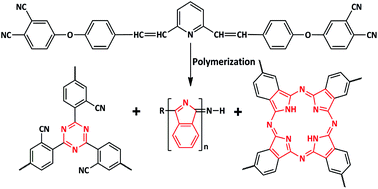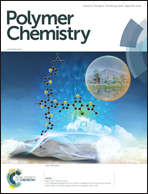A novel high temperature vinylpyridine-based phthalonitrile polymer with a low melting point and good mechanical properties†
Abstract
A novel vinylpyridine-based phthalonitrile monomer, namely 2,6-bis[4-(3,4-dicyanophenoxy)styryl]pyridine (BCSP), was synthesized from 2,6-bis(4-hydroxystyryl)pyridine (BHSP) via a nucleophilic displacement of a cyano-substituent with 4-nitrophthalonitrile (NPN). The phthalonitrile resin was cured with 4-(aminophenoxy)phthalonitrile (APPH), and its curing behaviour was investigated by differential scanning calorimetry (DSC), exhibiting a low melting point of 92 °C and an outstanding processing window of about 146 °C. The chemical structures of the BCSP monomer and polymers were characterized by Fourier Transform Infrared spectroscopy (FTIR) and Nuclear Magnetic Resonance spectroscopy (NMR). Different post curing temperatures and times resulted in polymers with different crosslinking levels and subsequently influenced the performance of the resins. The prepared BCSP polymer showed a high storage modulus (2.9 GPa–1.8 GPa) between 30 and 400 °C, a high glass transition temperature (Tg > 400 °C), and excellent thermal and thermo-oxidative stabilities with weight retention of 95% at 524.2 °C along with low water uptake.



 Please wait while we load your content...
Please wait while we load your content...